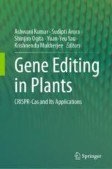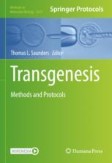Search
Search Results
-
A Cre-LoxP-based approach for combinatorial chromosome rearrangements in human HAP1 cells
Alterations of human karyotype caused by chromosomal rearrangements are often associated with considerable phenotypic effects. Studying molecular...

-
Recycling selectable markers via Cre/loxP system for constructing Komagataella phaffii strains co-expressing multiple proteins
ObjectiveA convenient strategy was developed to recycle selectable markers using Cre/ loxP system for constructing Komagataella phaffii strains...

-
Improving Sedum plumbizincicola genetic transformation with the SpGRF4–SpGIF1 gene and the self-excision CRE/LoxP system
Main conclusionS. plumbizincicola genetic transformation was optimized using a self-excision molecular-assisted transformation system by integrating...

-
VCre/VloxP and SCre/SloxP as Reliable Site-Specific Recombination Systems for Genome Engineering
The Cre/loxP system is a versatile and powerful tool that has been used to develop many kinds of genetically modified mice, such as conditional...
-
Keratinocyte-specific knockout mice models via Cre–loxP recombination system
Purpose of reviewThe Cre recombinase/loxP (Cre/loxP) system has emerged as a useful tool in genetic manipulations. Generally, any DNA sequence of...

-
Fast and efficient generation of a full-length balancer chromosome by a single Cre/loxP recombination event
Balancer chromosomes, primarily discovered and used in Drosophila melanogaster , are valuable tools to maintain lethal mutations in a particular...

-
Combined Use of Unidirectional Site-Specific Recombination System and CRISPR-Cas Systems for Plant Genome Editing
Site-specific recombination (SSR) systems have been extensively used for controlled genome modification in eukaryotic cells, especially for DNA...
-
Generation of Floxed Mice by Sequential Electroporation
Generation of conditional knockout mice using the Cre-loxP system is essential for the analysis of gene functions. The use of CRISPR-Cas9 in...
-
Lineage Tracing of Bone Cells in the Regenerating Fin and During Repair of Bone Lesions
Small teleost fishes such as zebrafish and medaka show remarkable regeneration capabilities upon tissue injury or amputation. To elucidate cellular...
-
Floxing by Electroporating Single-Cell Embryos with Two CRISPR RNPs and Two ssODNs
Floxed alleles and Cre drivers are two components of most conditional knockout mouse models, which are not only important for studying a given gene...
-
Targeted insertion of conditional expression cassettes into the mouse genome using the modified i-PITT
BackgroundTransgenic (Tg) mice are widely used in biomedical research, and they are typically generated by injecting transgenic DNA cassettes into...

-
Biolistic Transformation of Cryptococcus neoformans
Biolistic transformation of Cryptococcus neoformans is used as a molecular tool to genetically alter or delete targeted genes. The DNA is introduced...
-
Multigene Transformation Through Cre-lox Mediated Site-Specific Integration in Rice
Plant transformation with multiple genes is a major challenge, rendering multi-trait engineering extremely difficult in crop plants. One of the...
-
Application of RecET-Cre/loxP system in Corynebacterium glutamicum ATCC14067 for l-leucine production
ObjectiveTo explore the RecET-Cre/ loxP system for chromosomal replacement of promoter and its application on enhancement l -leucine production in Coryn...

-
Efficient deletion of LoxP-flanked selectable marker genes from the genome of transgenic pigs by an engineered Cre recombinase
Genetically modified (GM) pigs hold great promises for pig genetic improvement, human health and life science. When GM pigs are produced, selectable...

-
Efficient Detection of Flox Mice Using In Vitro Cre Recombination
Advances in CRISPR/Cas9 genome editing technologies have allowed for the rapid generation of Cre-loxP conditional knockout mice. However, current...
-
Cre toxicity in mouse models of cardiovascular physiology and disease
The Cre–LoxP system provides a widely used method for studying gene requirements in the mouse as the main mammalian genetic model organism. To define...

-
The potential oncogenic effect of tissue-specific expression of JC polyoma T antigen in digestive epithelial cells
JC polyoma virus (JCPyV), a ubiquitous polyoma virus that commonly infects people, is identified as the etiologic factor for progressive multifocal...

-
Ribo-On and Ribo-Off tools using a self-cleaving ribozyme allow manipulation of endogenous gene expression in C. elegans
Investigating gene function relies on the efficient manipulation of endogenous gene expression. Currently, a limited number of tools are available to...

-
Recombineering-Mediated Genome Editing in Burkholderiales Strains
Red/ET recombineering is primarily mediated by the E. coli recombinase pair Redα/Redβ from λ phage or RecE/RecT from Rac prophage, which is applied...
